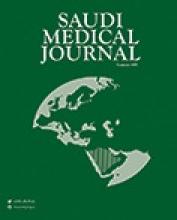Abstract
OBJECTIVE: To determine the prevalence of Methicillin Resistant Staphylococcus aureus (MRSA) colonization in our institution.
METHODS: A 5-day period prevalence study of all adult and pediatric patients. Excluded areas were the adult intensive care unit (screened on admission and weekly thereafter), the outpatient hemodialysis population (screened monthly), and newborns. Our facility is a referral/teaching hospital for the National Guard population and their dependants in Western Saudi Arabia. A total of 240 patients were screened. Nasal sampling was carried out and isolation/identification of MRSA was performed using standard microbiological methods.
RESULTS: The total number of patients sampled was 240 and of those 10 (4%) were colonized. The 10 positives were found in 4 patient care areas; adult male medicine 5, adult male oncology 3, adult female medicine one, adult high dependency unit one. These patients care areas had 69 patients (42 males and 27 females). Ten (14%) were colonized by MRSA; 9 males (21%) and one female (3%). Statistical analysis Chi Square for discontinuous variables, "F" test for continuous variables found that one), male gender (p=0.04), 2) the presence of a long term invasive device (p=0.04), 3), length of stay (p=0.004) were predictive of MRSA colonization.
CONCLUSION: The overall prevalence of MRSA colonization in our hospital was low, however a sub-segment of the population identified as male, having long term invasive devices, and hospitalized more than 2 weeks, were frequently colonized. Any strategy, in our hospital, to control the spread of MRSA should include the testing of this population.
- Copyright: © Saudi Medical Journal
This is an open-access article distributed under the terms of the Creative Commons Attribution-Noncommercial-Share Alike 3.0 Unported, which permits unrestricted use, distribution, and reproduction in any medium, provided the original work is properly cited.






